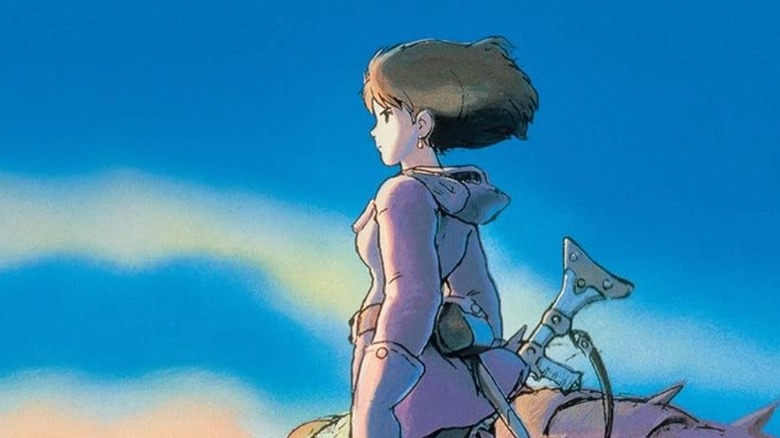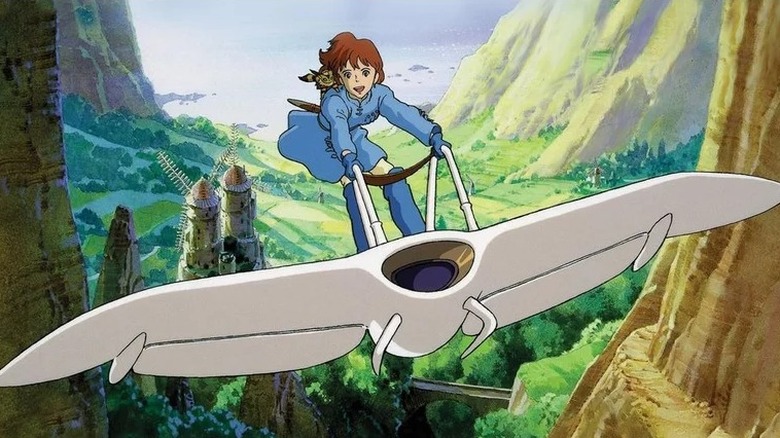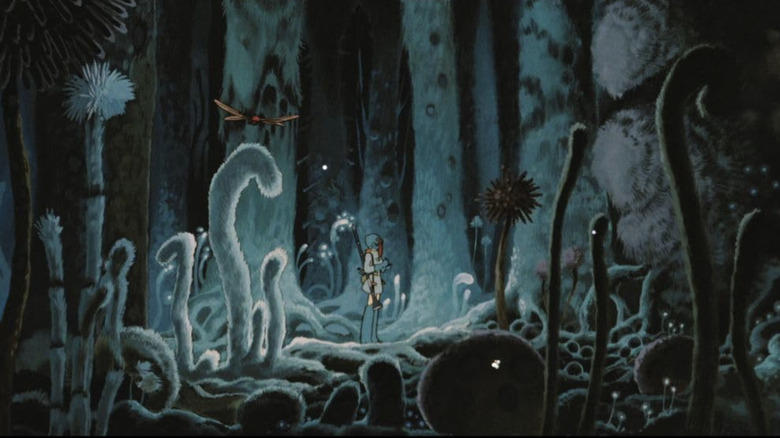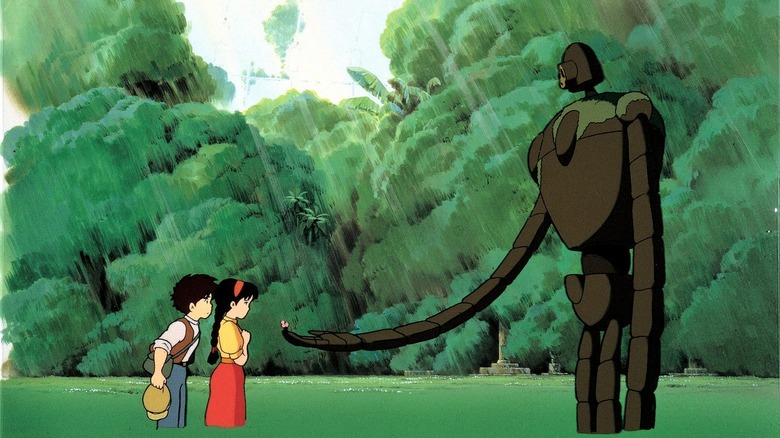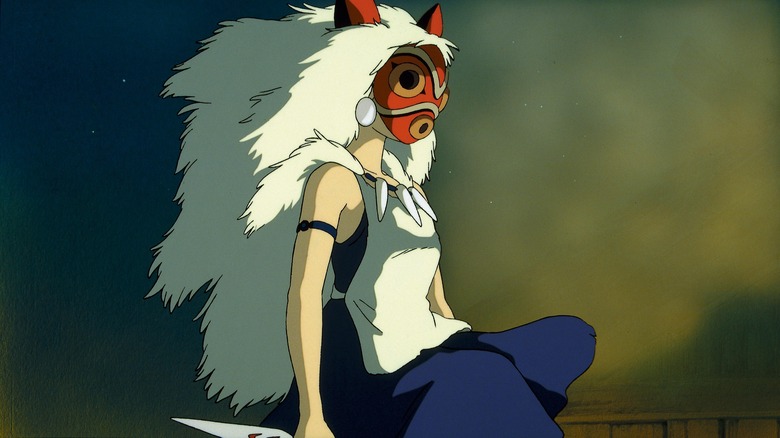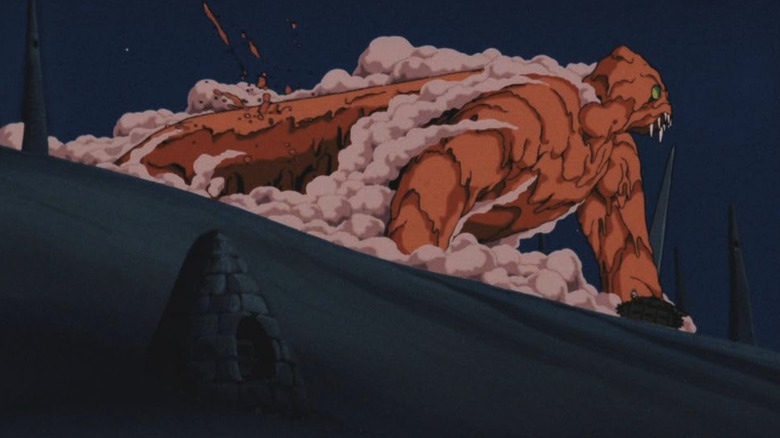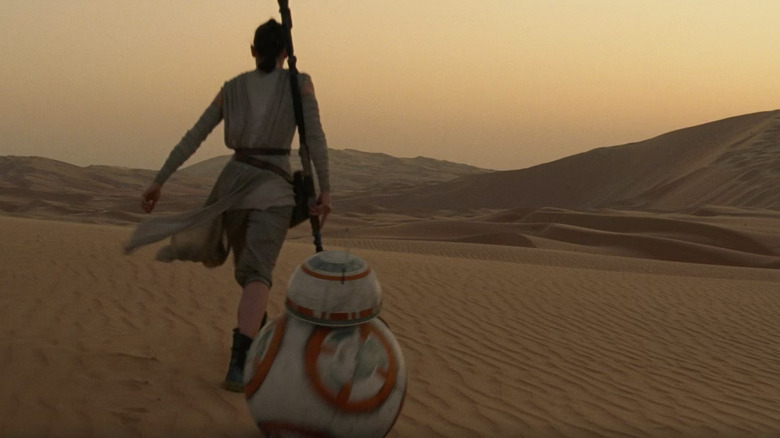Nausicaä Of The Valley Of The Wind Set The Stage For Decades Of Stunning Studio Ghibli Anime
Studio Ghibli is often considered synonymous with filmmaker Hayao Miyazaki, director of the studio's best movies. Many would argue Miyazaki's works are some of the best animated movies ever, so it's natural that he casts a shadow over the studio he helped build.
However, the studio actually has multiple founders: the late director Isao Takahata, producer (and current studio chairman) Toshio Suzuki, and Yasuyoshi Tokuma. The latter's company Tokuma Shoten offered the foundation for Ghibli and was the studio's parent company from 1985 to 2005.
Miyazaki was already a prolific animator pre-Ghibli and acquainted with Suzuki and Takahata. The three first made a movie together in 1984: "Nausicaä of the Valley of the Wind." Miyazaki directed, Takahata produced, and Suzuki was the one who first connected Miyazaki with Tokuma Shoten. As a bonus, composer Joe Hisaishi (who went on to be Ghibli's in-house composer) also scored "Nausicaä."
1000 years in the future, the Earth is unrecognizable after an apocalyptic "Seven Days of Fire." Most of the planet is a wasteland or a "toxic jungle" infested with giant bugs. Small pockets of humans live in isolated kingdoms; the film's title refers to the princess of one such kingdom (which keeps out toxic spores with wind turbines). When the expansionist kingdom Tolmekia discovers one of the ancient "God Warriors" that killed the old world, Nausicaä realizes her destiny to save the new one. Likewise, "Nausicaä" is what first realized Miyazaki's destiny as the maestro of anime.
Hayao Miyazaki created Nausicaä of the Valley of the Wind as a manga and movie
The story of "Nausicaä" begins not on screen, but on page. Miyazaki first wrote the story as a manga in 1982, which is how he partnered with Suzuki.
At the time, Suzuki was the editor of the magazine Animage (published by Tokuma Shoten). He first encountered Miyazaki and Takahata in 1978 while trying to interview them about the 1968 film "The Great Adventure of Horus, Prince of the Sun" (Takahata directed, Miyazaki was key animator). The following year, Suzuki saw Miyazaki's directorial debut, "Lupin III: The Castle of Cagliostro" and reached out to him again.
During that interview, Miyazaki mentioned his idea for "Nausicaä" as an animated film and Suzuki was taken with the story. Since making a feature film based on an original idea would be a tricky investment, Suzuki convinced Miyazaki to write the "Nausicaä" manga as a proof of concept, which he would serialize in Animage. The manga was an instant hit and proved the film was viable.
So, while "Nausicaä" was introduced to the world as a manga, Miyazaki always envisioned the story as an anime. You can see that with the short production timeline; the movie was in theaters when the manga was only two years old. However, Miyazaki didn't abandon the story once his ambitions for it had been met. The "Nausicaä" manga ran until 1994, so the film went from being the fully-realized version to only a partial adaptation. That does nothing to diminish the film's beauty, though.
Nausicaä of the Valley of the Wind is a world-shattering fairy tale
"Nausicaä" is told in the style of "Dune" — both stories are set on near-dead worlds, have giant bugs, and center on prophesied messiahs born of royalty. Despite the similarities, "Nausicaä" has plenty of merits that are all its own.
The film's aesthetic mixes "Mad Max"-esque post-apocalyptic rummage tech with medieval Europe. Most of the villagers in the provincial Valley of the Wind wear the simple clothes of peasants, while the soldiers of Tolmekia are clad in the shining armor of knights. Their princess, Kushina, is dressed in white and gold robes — not to mention a brass arm to replace one taken by the bugs. There's even Western imagery thrown in; the movie opens with Lord Yupa of the Valley of the Wind wearing a wide-brimmed hat and riding a flightless bird as if on horseback, investigating a deserted village that seemingly fell as the toxic jungle grew.
The monarchical structure of the world in "Nausicaä," with different kingdoms rivaling each other, echoes the medieval world, so drawing from the imagery of that era is intuitive. At the same time, the technology (from the gas masks all must use outside the Valley to Tolmekia's imposing airships) reflect this is a mismatched world unlike any in history. It's a world that has regressed and must make do with leftovers from those who came before.
Though "Nausicaä" is technically not a Ghibli film, it has all the pet themes Miyazaki would touch on again in his later films. Aviation is one of his passions; in "Nausicaä," one of the main ways of traveling are nimble, one-person gliders where the rider stands atop them and holds the reins like a sleigh. Then there's an environmental message at the core. The toxic jungle and its bugs are Earth's response to humankind nearly destroying it; they're cleansing the poisoned soil, not spreading it. If humans wipe out the enormous Ohms like Tolmekia wants, they'll be repeating the mistakes of a millennium past.
Studio Ghibli was founded in 1985 and debuted with Castle in the Sky
Studio Ghibli is the house that "Nausicaä" built. After the success of "Valley of the Wind," Miyazaki, Takahata, and Suzuki solidified their partnership and founded Ghibli in 1985. The new studio absorbed much of the staff and assets of Topcraft, a studio that worked on "Nausicaä" before dissolving. As for the name "Ghibli," that isn't a native Japanese word. Miyazaki got it from Italy, where it means "hot desert wind." The word had previously been used as the name of a 1930s Italian spy plane ("Caproni Ca.309 Ghibli"), again showing Miyazaki's love for flying.
Ghibli's first official film, "Castle in the Sky," premiered in 1986. In a fantasy world (inspired by Wales, which Miyazaki had recently visited), orphans Sheeta and Pazu meet and find themselves chased by the military and sky pirates. Sheeta carries a crystal necklace that is believed to lead to Laputa, a floating city home to advanced technology and a robot army.
The world of "Castle in the Sky" is lusher than that in "Nausicaä," but the two movies feel spiritually linked. Miyazaki's films became famous for their more leisurely pacing (see: "Kiki's Delivery Service") but his earlier works don't have such patience; "Nausicaä" is about burgeoning war and "Castle in the Sky" is a chase/adventure movie in the vein of "Indiana Jones."
"Castle in the Sky" has a similar environmental message too. In both movies, the villains want to control ancient weapons that would be better kept locked away. The pop culture of Japan (the only country to ever experience an atomic attack) often shows superweapons as ultimate evils. Miyazaki adds shades of nuance (the robots of Laputa can be gentle guardians if not controlled by a vicious individual) but his movies still feel influenced by his country's industry and his love for Earth's natural beauty. At the climax of "Castle in the Sky," the industrialization of Laputa cracks away, leaving only a floating tree behind.
Miyazaki returned to the themes of Nausicaä in Princess Mononoke
Miyazaki's Ghibli films often draw from European architecture and landscapes, but his masterpiece is also one of his most Japanese films: 1997's "Princess Mononoke." In the 14th century, the first industrialization has come to Japan. The settlement "Iron Town" has made factories and firearms, ensuring prosperity for its inhabitants (even the downtrodden, like sex workers and lepers, are equals in Iron Town).
Iron Town's resources come from deforestation, which angers the old gods who called those woods their home. San, a girl raised by wolf gods, wants to destroy Iron Town. Ashitaka, a young prince whose village was attacked by a boar spirit that turned demonic after being shot, is in the middle of this conflict.
Compared to "Nausicaä and the Valley of the Wind," San is Nausicaä; a plucky teenage girl on a mission to save the Earth (though San is much more violent than Nausicaä). Lady Eboshi, leader of Iron Town, is Princess Kushana; a leader of a powerful state who thinks she can uplift her people through destruction.
"Nausicaä" is more black-and-white (Tolmekia is wrong and destroying the Ohms would be catastrophic), while "Princess Mononoke" is less so. Ashitaka (and the audience) meets the people of Iron Town before San so we get both sides of the story. The film acknowledges how industrial revolutions can often bring about progressive societal reform; capitalism is a necessary stepping stone for a feudal society to do away with ranks and stratification. In a system where one's value is their labor and skills, not their name, anyone (even a lowborn like Eboshi) can rise to the top. But is a more comfortable life for certain humans worth the destruction of the land in which we live and build on? It's a question that grows more pressing every year.
Neon Genesis Evangelion creator Hideaki Anno got his start on Nausicaä
The impact of "Nausicaä" on the anime industry is not confined to Studio Ghibli. It also made the career of Hideaki Anno, future creator of "Neon Genesis Evangelion," who animated the scene near the film's end of the God Warrior coming to life and melting into nothingness.
As chronicled in mini-documentary "The Birth of Studio Ghibli," "Nausicaä" was falling behind its production schedule. So, Suzuki put out an ad in Animage calling for more animators to apply. Anno was one of them and his portfolio impressed Miyazaki so much that he gave him the arduous task of animating the God Warrior.
Later in 1984, Anno co-founded the studio Gainax. That was the studio where he directed "Gunbuster," "Nadia: The Secret of Blue Water" (co-created with Miyazaki), and ultimately "Evangelion" in 1995. The impact of that series, even almost 30 years later, can't be understated. Anno left Gainax in 2006 to found a new studio, Khara, and took "Evangelion" with him. After being hollowed out in the 2010s, Gainax recently went bankrupt in May 2024 — but that's a story for another time.
Anno wasn't the only wiz kid in Gainax's employ, though. Other classics in the studio's catalog also includes "FLCL" (forget the sequels) and "Gurren Lagann." The latter's creator, Hiroyuki Imaishi, helped co-found his own studio, Trigger, that's worked on everything from anime features like "Promare" to an episode of "Star Wars: Visions." Miyazaki and Ghibli can be seen as the artistic grandparent of Trigger.
So, how do Anno's contributions to "Nausicaä" fit in with his body of work? The giant God Warriors in "Nausicaä" (and the robots of Laputa) are humanoid WMDs; of course humanity would build the vehicle of its destruction in its own image. Anno would explore this theme again in "Evangelion," a series where humans, their mecha defenders, and kaiju attackers are born from a common seed.
The international legacy of Nausicaä and Studio Ghibli
The influence of Studio Ghibli is well-felt outside Japan. Miyazaki and Ghibli's latest film, "The Boy and the Heron," won Best Animated Feature at the 96th Oscars and deserved it. Ghibli's pictures are, alongside "Cowboy Bebop," often described as the perfect gateway anime for Americans. (Miyazaki's movies are more child friendly than "Bebop" too — aside from all the decapitations in "Princess Mononoke" — so they're good for making weebs while they're young.)
As for "Nausicaä" itself, you can notice Hollywood blockbusters cribbing from it if you know where to look. The opening scenes of "Star Wars: The Force Awakens" have been compared to those in "Nausicaä." Rey (Daisy Ridley), a nobody scavenger and future Jedi hero, is introduced on the desert world of Jakku scavenging, à la Nausicaä's first scenes in Valley of the Wind. The two heroines even wear similar masks.
This year's "Kingdom of the Planet of the Apes" also feels like a "Nausicaä" inspired work. Both films hit similar beats: a small, idyllic village in a post-apocalyptic world is raided by attackers from a more powerful neighbor. The child of the village's slain leader must go on a quest to stop a tyrant from controlling ancient weapons. Neither "The Force Awakens" director J.J. Abrams nor "Kingdom" director Wes Ball has directly confirmed "Nausicaä" as an influence on them, but a film being an unconscious inspiration for other artists can be a sign of how ingrained it is in culture. The works of Studio Ghibli, which all go back to "Nausicaä and the Valley of the Wind," have reached such status.
